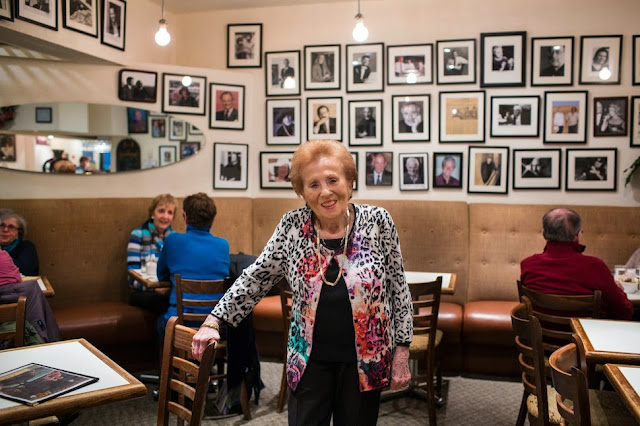Remembering Ann McColl's Kitchen Shop
Ann McColl Lindsay and David Lindsay: A Brief History of a Road Less Traveled
Hospitality and the culinary arts have always gone
hand in hand. In London, Ontario, we have a history of exceptional restaurateurs,
chefs and culinary retailers. Among the latter are Ann McColl Lindsay and David
Lindsay, the former proprietors of the legendary Ann McColl’s Kitchen Shop, one
of Canada’s finest cookware shops.
Ann and David met, married and taught school in Windsor,
Ontario from 1961 to 1968. They resigned their positions, sold their red brick
bungalow, and embarked on a year-long food pilgrimage across Europe while
camping in a Volkswagen van. Travelling
in the van with a gas burner allowed them to truly enjoy the local terroir.
The first six months of their trip, which ended at the French border, is described in Ann’s memoir Hungry Hearts – A Food Odyssey across
Britain and Spain. The second volume, Hearts
Forever Young, includes their travels in France, Italy, Austria,
Switzerland, Germany, Belgium, the Netherlands and Denmark.
This formative trip introduced the Lindsays to small
independent grocers, hardware stores, street markets and antique stores jammed
with domestic serving pieces. It was during this time that they started to
collect the one-of-a-kind utensils that would comprise a useful and saleable batterie de cuisine. Of a foray to
British food writer Elizabeth David’s Kitchen Shop, Ann says, “This innocent
morning’s shopping expedition turned into a lifetime obsession”.
Upon their return to
Canada, they opened Ann McColl’s Kitchen Shop and Victoriana in rented premises
on Dundas Street where they lived above the shop. They specialized in culinary utensils,
antiquarian books, furniture, and Victorian paraphernalia.
I should point out here that it was about this time that the
Lindsays befriended restaurateurs Ginette Bisallion and Robin Askew, who opened
the seven-table L’Auberge du Petit Prince ((named after Antoine de
Saint-Exupery’s Little Prince, who, if you remember, cooked over volcanic jets
on a far planet). L’Auberge was later purchased by chef Chris Squire in 1976.
Squire would operate the landmark business for 21 years. These steadfast relationships
cemented their connection to the local restaurant scene.
After
several years on Dundas Street, the Lindsays moved to new premises with
beautiful storefront windows, on Richmond at Hyman Street. It was one of just
three small owner-operated specialty shops on Richmond Row at the time. Ann
started to write cookbooks. David, a talented artist and photographer,
illustrated them.
In 1977 Ann authored
The Cookshop Cookbook, which instructed
readers in the use and care of kitchen utensils and equipment. “We had always been traditionalists in the matter of
kitchen equipment, shunning all electrical contrivances and putting our faith
in good knives, sieves, mortar and pestles. The autumn of 1975 saw a change in
all that. The Cuisinart Food Processor arrived in Canada and automatically half
the stock in our store became obsolete,” wrote Ann. The business prospered
anyway and they outgrew that location.
In the 1980’s they relocated the shop to 350 Talbot Street. Built
in 1890, the building was originally erected as a showroom and repair shop for
Massey-Harris Co. To this day, the landmark building provides a strong reminder
of the late nineteenth century commercial activity in downtown London. The new
store was one of the most professionally stocked and artistically merchandised
cookware shops anywhere. It had
everything you needed to be a successful cook, except the food. The shop
offered bakeware, pots and pans, woks, scales, utensils, gadgets, drain boards,
glassware, bowls, and many specialty utensils. There was even a step-down
kitchen in the renovated tractor repair shed with an AGA stove for cooking
classes and demonstrations.
Already outspoken heritage
activists, having had four of their buildings designated, they campaigned for
the preservation of the streetscape on the Talbot Block which culminated in a
“Hands Around the Block” demonstration. Ann’s commentaries on culinary matters,
urban issues and heritage preservation have appeared in countless newspaper articles,
magazines and letters to the editor over
the years.
In 1994, the Lindsays published Ann McColl’s 25 Greatest Hits, which showcased 25 of the store’s
greatest products beautifully illustrated by David. Eventually, they would sell
this building and move the business to King Street, across from the Covent
Garden Market.
The Lindsay’s announcement in 2002 that they were retiring
and closing down their store on King Street presented the opportunity for Jill
Wilcox to expand Jill’s Table into that location. The space was four times
larger than Jill’s original market space. Jill’s Table was able to fill part of
the vacuum that Ann McColl’s was leaving in the community.
During the 33 years they ran their kitchenware business the
Lindsays were also avid gardeners at their home in Woodfield, and in community
gardens. A few years ago, Ann was instrumental in recreating the original
Victorian herb garden at Eldon House. To this day the Lindsays are fondly
remembered as the benchmark example of how to blend culture and commerce. They
continue to be intrepid market enthusiasts, artists, heritage preservationists
and community boosters.






such a nice post!!
ReplyDeleteMust have a look at Tips to Check the Most Common Dishwasher Issues
This shop was the highlight of my childhood. Growing up in a small farming community I would covet the times we were able to get into the core of London and explore. It served as a catalyst for my life in search of beautiful, functional objects and appreciation for well merchandised retail environments. To this day, I think about the beauty of this store and the ethos of their lives and the impact they had on the community. What a beautiful story, thank you for sharing.
ReplyDelete